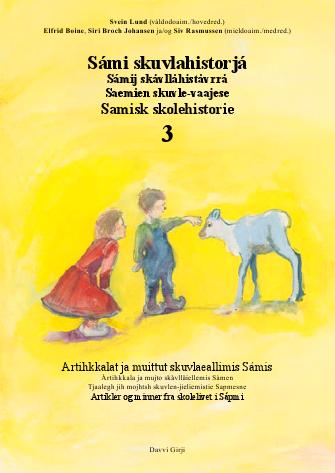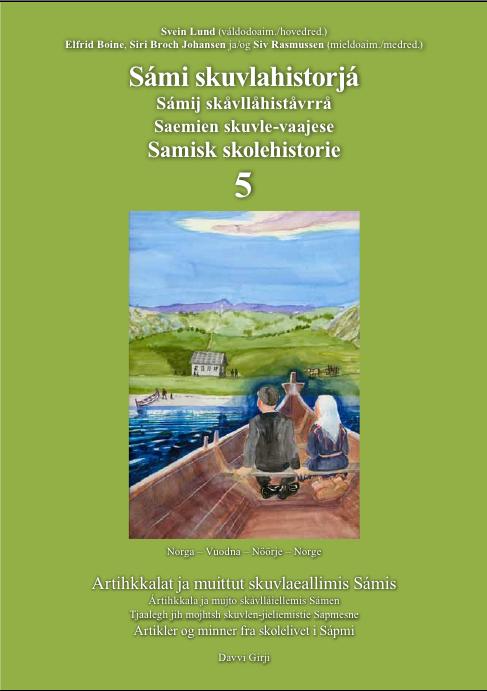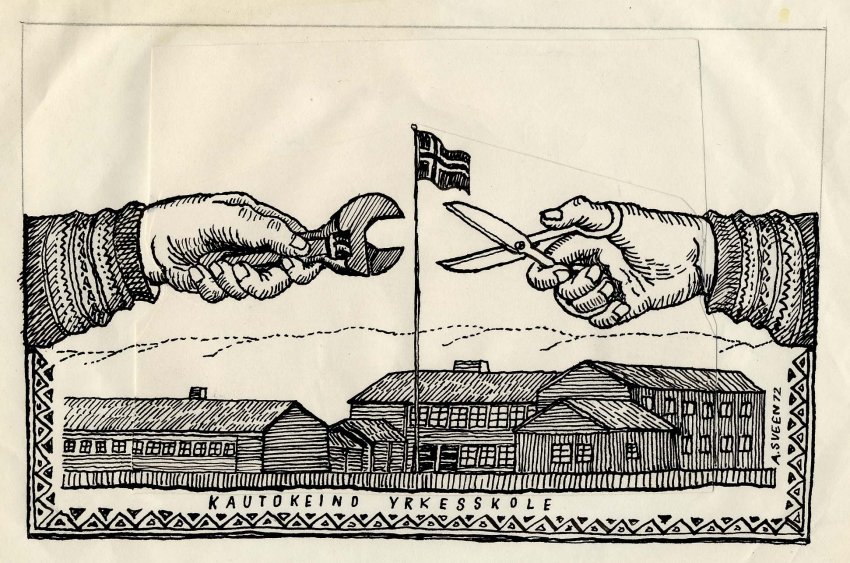 Sámegillii
Sámegillii  På norsk
På norsk
Articles about Sami school history
Part 6 - published in Min Áigi 02.11.2007
    
Do you know Sami school history?Sámi skuvlahistorjá / Samisk skolehistorie (Sami School History) is a series of books published by the publishing house Davvi Girji. In about 200 articles in 5 volumes there is told about the experiences of Sami children in Norwegian schools, and about the changes in the educational politics of the Norwegian authorities towards the Sami population. The books are published with parallell text in Sami and Norwegian language.In this web site some of the articles of the first book are also published in English. It would be too much to translate it all, so to make this history available to a greater public, we are translating a series of newspaper articles, which sorted by topics make a summary of stories in the books. So far there are 28 articles published in Sami language by the Sami newspapers Min Áigi and Ávvir. They are also published here in Norwegian and the English version will be published gradually as they are translated. These articles are edited by the main editor, Svein Lund. Besides him the editing board of the book series consist of Elfrid Boine, Siri Broch Johansen and Siv Rasmussen. |
"Alongside the measures mentioned by the Ministry of Education and Church Affairs, the County Council would like to suggest that aims to build a permanent handicraft school for Sami youths should be taken. This school should be placed in Kautokeino which is by far Finnmark's largest reindeer-municipality, and in the first round one should aim at professional education of Sami boys related to the work of utilising the products of the mountains (bone crafts, preparation of reindeer skin, carpentry etc.).
The County Council regards this as a huge and important task, first of all because professional education within the fields already mentioned will instantly provide and create the best foundation for a profitable home-profession in our mountain based municipalitys. ....
If one looks at the development within the reindeer husbandry over the past decades it becomes clear that even though the number of reindeer has an annual growth, there is a decline in the number of people who have this occupation. On the other hand there is an increase in the number of settled Sami who are destined to a barren agriculture without market potential and a small amount of catching and fishing.
One is here facing a large scale occupational problem that can, at least to a certain degree, be eliminated by a systematical development of the home-profession, based on quality and with a preservation and further development of the old Sami culture of arts and crafts. The County Council will therefore form a committee who's work it will be to continue this task and present specific suggestions for acheivement of this plan."
In relation to this it is noteworthy that the handicraft school emphasised Sami culture to such a degree. The first aims of the planning group were very specific:
1. Create a foundation for an improvement of the economy - of both settled and nomadic Sami.
2. Revive the sense and respect for the great values within Sami culture and language.
3. Revive and make certain the sense of style and taste. Locate and instil the characteristic Sami features in cutting fashion, patterns and
ornamentations. This with consideration to the fact that one can have pupils from different Sami regions with their own regional distinctive
features.
The courses included in the practical education are in line with these aims and illustrate that through this work, the Sami culture and Sami knowledge is viewed as the primary foundation of this school.
(Heimeyrkesskolen, SSH-2)
 |  |
| The pupils Kristine T. Turi and Ellen Kristine A. Juuso are weaving bands for fur shoes. (Photo: State handicraft school for Sami / The National Archives ) | From the carpentry room. In front: Johannes Keskitalo. (Photo: State handicraft school for Sami / The National Archives) |
It was named Statens heimeyrkeskole for samer i Kautokeino (State handicraft school for Sami), and as the name illustrates, the aim of the teaching was first of all directed towards the practical work associated with the Sami homes. It is not our intention to provide a vocational training for crafts and industry with the result that the youths have to move to the cities to find suitable work when they graduate. The point of departure is the Sami environment and society as we know it today.
The school also has a cultural programme. It will try to teach the Sami youths respect for Sami culture and Sami traditions and revive the
youth's self-esteem. One has therefore in the programme heavily emphasised that the school should be a home to Sami and that the teachers should have close relations to the Sami society, and preferably be Sami themselves. The school can not be a true home as long as they teach in a foreign language because the teachers do not speak Sami. The language of instruction should also be Sami due to numerous other reasons - just think about all the terminology related
to the reindeer husbandry.
(Ragnar Nordby's speech, SSH-2)
In 1955 the exam consisted of dictation and composition, and in 1956 of dictation and translation. In relation to the exam in 1955, Henriksen wrote a covering letter to headmaster Sigurd Skoglund in which he commented: "Bongo must have put great efforts into the Sami training, considering that what is shown is the results of barely 10 months of teaching altogether when it comes to writing and orthography."
In 1955 it were in addition to a written exam also an oral exam and an exam in Sami history.
It seems like Sami was to a large extent used as the language of instruction. There were at least no demands to use Norwegian when the teachers and pupils spoke Sami. On 08.04.1952 the vocational-school board proclaim: "The language of instruction should be Sami whenever possible, at least in the practical subjects."
STATENS HEIMEYRKESKOLE FOR SAMER (State handicraft school for Sami)
– KAUTOKEINO –
The school admits pupils for the school year 1960/61, which will begin in
October. Everyone who has completed primary and lower secondary school may
apply. The school offers the following fields of studies:
A. Wood work.
B. Iron and metal work.
C. Weaving and sewing.
D. Various courses.
In relation to the practical tutoring there will be provided theoretical tutoring. There are no study fees and there will be an
opportunity to apply for scholarships to cover travel and living expences. The school has dormitories on nice new premises, and there will be arranged full provisioning of the pupils. For further information please contact the school, adress: Kautokeino. Applications should be sent as soon as possible.
 | Drawing: Arvid Sveen, 1972 |
In a note from Reidar Marmøy from RVO (Council of secondary education) 1978 the changes are described as the following: "The curriculum was changed in accordance with the A-plan of the vocational school during the school year 1962/63. This lead to discontinuation of characteristic Sami activities. The school became an ordinary vocantional school but Sami youths should still be prioritised for admittance."
"It is with great regret one points at the tendencies revealed at the Sami handicraft school in Kautokeino. These
tendencies threaten to help develop the school in the direction of regular vocational schools with a minimal presence of Sami
characteristics. The Council is of the opinion that the school is justified through its additional function of maintaining and reviving
the respect of cultural values characteristic of the Sami society (both materialistic and spiritual), and the creation of an environment in which the Sami culture may thrive and gain vitality
.
The Council is of the opinion that a vocational education without cultural characteristics at this school cannot be justified. Regular vocational education of Sami youths will be more efficient at other vocational schools within the County or the rest of the country. The Council will consequently request an immediate revision of the curriculum. The revision must take into consideration the specific purposes the school was intended to serve, such as they are described in the name of the school and the documents of which the establishment of the school was based upon."
Here you find all the articles in the series:
28.09.2007 Why Sami school history?
05.10.2007 Boundless ignorance
12.10.2007 Southerner-teachers encounter the Sami language
19.10.2007 The start of Sami beginner instruction
26.10.2007 The start of education in reindeer-herding
02.11.2007 From Sami to Norwegian vocational training
16.11.2007 Struggle for Sami gymnasium
28.11.2007 School experiences of Norwegian speaking Samis
14.12.2007 Resistence against Sami language and culture
25.01.2008 A strange world
23.05.2009 On Sami teachers
30.05.2009 Life in boarding school
06.06.2009 Sami pupils were bullied
13.06.2009 Sami content in the teaching
20.06.2009 Pupil as interpreter
04.07.2009 How the children quit speaking Sami
10.09.2010 God does not understand Sami
08.10.2010 The point of view of the Norwegianizers
13.10.2010 Men of the church defending the Sami language
02.12.2010 Sami teachers in old times
09.12.2010 Boarding school life in old times
18.12.2010 Sami pupils in special schools
14.01.2012 The parents' struggle for Sami education
21.01.2012 Reluctance and absence
28.01.2012 The school during the war
04.02.2012 Reconstruction and barrack schools
11.02.2012 Curriculums - for Norwegianization and for Sami school
18.02.2012 The great struggle of the curriculum
Sami school history 1
Sami school history 2
Sami school history 3
Sami school history 4
Sami school history 5
Sami school history - main page